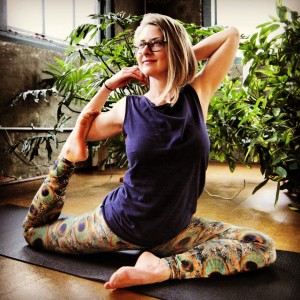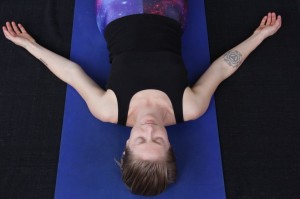Jennifer Siegel wants you to relax. “For every three power vinyasa classes you take, you might consider taking a restorative,” she said recently over tea at Floyd’s Coffee. Siegel, a massage therapist-turned 500-hour yoga therapist, trusts her students to know their bodies best. She does what she can to make poses more accessible, rather than to force someone’s body to conform to a pose. “I’m not trying to perpetuate dysfunction just for the sake of tradition. I’m an anatomist. I prefer science. If something doesn’t feel right in your body, I trust you to know it.”
Ballet Body
As a young ballerina, Jennifer was familiar with traditions that stress form over function. She started dancing when she was very young. By the time she hit puberty, ballet felt all wrong. “Overextended joints and hyper-flexibility, combined with scoliosis, was really ugly for my body when it was growing and changing,” she said. When she developed curves, her dance teacher informed her that she was not headed for ballet greatness. She quit dancing. “My chiropractor said if I stopped moving, I’d get hit with a world of pain. He pushed me toward yoga.”
At age 15, Jennifer started checking out yoga books from the library. She dabbled in yoga for many years before deciding to teach.
Massage and Hospice
Jennifer became a licensed massage therapist in 1999. She developed a specialty of working with hospice patients. In 2005, a job was created for her as the only paid hospice massage therapist in Portland.
“I’m not afraid of dying stuff,” she said. “Some people have the constitution for it, some don’t. I’ve never wanted to work in an average context. I always want to be around the exceptional. People who have accepted their fate are exceptional, whether they’re homemakers or presidents of companies.”
She appreciated the wisdom her dying patients shared. “People become hyper-intelligent when they’re dying,” she said. “Lots of patients said they wish they’d taken advantage of their own inner wisdom before it was too late. They realize they could have been active about their health, not given away their power.” She heard lots of people say they wished they’d never had back surgery. And she met many people who retired, decided to take better care of their physical health, but found out they had cancer. “They worked, worked, worked, their whole lives. They literally worked themselves to death.”
While working in hospice, Jennifer cultivated the voice that would later serve her so well in her restorative yoga and yoga nidra classes. “When someone is physically uncomfortable, it helps to have a calm voice,” she said. She became so renowned for her voice that the nurses on staff at retirement homes she visited joked about her making a recording saying, “Residents, it’s time for lunch.”
Teaching Yoga
By 2008, doing so much massage was taking a toll on Jennifer’s body. She decided to teach yoga. She began by studying yin yoga with Bernie Clark at a Buddhist monk retreat center in the Canadian mountains.
She followed that up with vinyasa training at Core Power in Portland’s Pearl District. Both the setting and subject matter were a big change from yin. Instead of holding poses for five minutes, suddenly she flowed through poses at a rapid clip in a 100-degree room with 50 other people.
“I realized I’d make my success as a yoga teacher by fixing injuries perpetuated by that form,” she said. “When you’re moving so fast through time and space with no thought, it’s an inevitability you’re going to get hurt.” But she learned some useful lessons at Core Power, including teaching yoga to a variety of people and using simple language.
Jennifer further refined her direction by taking a yoga therapy course at Kripalu in 2011. Through this, she got her 500-hour certificate with the International Yoga Therapists Association. At Kripalu, she discovered yoga nidra. Her yogic focus has since been nidra, restorative and yin. “I want a gateway to meditation,” she said. To her, yoga is not meant to be exercise. “If you need yoga to be a workout,” she said, “go to CrossFit. Learn functional movement.”
Yoga Nidra
Yoga nidra, also called yogic sleep, is a deep, guided meditation done in savasana. The goal is to keep the mind awake while the body sleeps. While at Kripalu, Jennifer did yoga nidra every day for a month, guided by nidra experts—Joseph and Lillian LaPage and Jennifer Reis.
Most of the time, Jennifer fell asleep during the yoga nidra sessions. Her yoga therapy course was so intense and tiring, and nidra was so relaxing. “It was quite the respite for rebalancing my hip or straightening out my spine every day,” she said.
When teaching yoga nidra, the leader follows a script. She instructs participants to relax various parts of their body, and to set an intention for their session. To deeply relax the brain, she guides students in imagining opposites: lying relaxed in the scorching desert, then lying on a cool raft in the middle of the ocean. There’s also lots of counting backwards from high numbers.
Jennifer writes her own scripts, adapting them from Swami Satyananda Saraswati’s formula. Inspired by the hospice patients she worked with, she devises ways to get people to go deeper. “If we can go internal and truly listen to our body’s own inner wisdom, it saves so much heartache,” she said. “I believe completely that we have that potential within our puny human brains.”
Her scripts include scenarios like imagining yourself in another body in another time period, or driving your spaceship through quiet, dark space, whizzing by stars. “I feel like I’m doing experimental nidra work,” she said. “The worst that happens is we have a silly, fun experience. The best is we’ll prevent an illness.”
Nidra in Action
Jennifer feels that yoga nidra is the most efficient tool to accomplish what she wants to help people accomplish. Often she tailors the nidra to the client. She’s done one-on-one personalized yoga nidra at the mixed martial arts gym where she works. “I work with a female MMA fighter who throws a terrible punch,” she said. “Because she doesn’t actually like getting hit and she doesn’t really want to hit anybody. You can’t be like that in MMA. So if she’s actually serious, she has to get over her fear of being hit in face.”
Jennifer devised a nidra with the goal of improving the fighter’s punch. “I had her in her yoga nidra watching herself train, observing what coaches are telling her and if she’s taking in that advice.” Together they worked on her fear. “We did yoga nidra work where she watched herself get hit over and over and over again. It was effective because she’s not afraid of getting hit anymore. It was very powerful for her.” The fighter has since been hit several times and is no longer afraid.
One-on-one sessions have also helped clients cultivate love in relationships and get relief from pain associated with back surgery. Jennifer thinks nidra is especially effective in conjunction with talk therapy and somatic approaches such as Feldenkrais.
Jennifer’s Future
Currently, Jennifer teaches at Shakti House, North Portland Yoga, Next Level Fitness and Alive MMA, where she’s an injury prevention specialist. In the future, she’s considering doing more one-on-one yoga therapy and specific applications of what she’s learned in school. “I love the instant gratification of working with athletes. But I think it’s time to expand into other populations. I like working with medically fragile people. I’m a really good pain reliever.” She’s worked with patients with MS, and would like to work more with depression, diabetes and heart conditions. “I like cultivating love, not fear.”
She hopes that insurance companies will begin to create a culture of prevention rather than disease. “I’d like to come to a point where everyone could take control of their own healthcare, not have to buy into this system,” she said.
To prevent disease, people need to take more responsibility, Jennifer said. “They should try not to overreact, to give in to the triggers that lead to stress. If I can do it—I’m not any better than anyone else—there’s no reason other people can’t do it, too.”
Relaxation is essential to balance people’s stressful lives, Jennifer said. If you spend eihgt hours a day stressed, she said, you need to spend eight relaxing via meditation, sleep, or other outlets that relax you. “You have to balance it. You can’t live in a world where you just accumulate tension, accumulate tension, then just break.” She stops and thinks for a second, then acknowledges people’s responsibility. “I mean, you can. But you don’t have to.”





